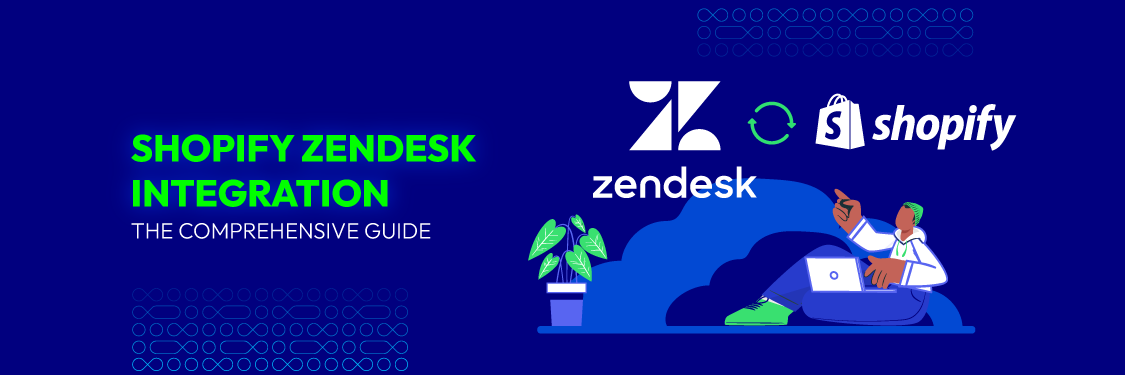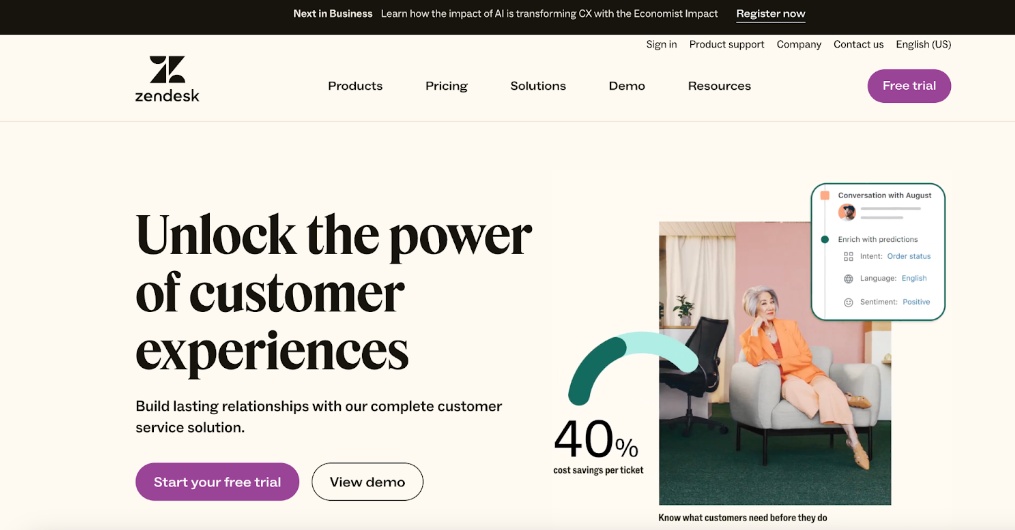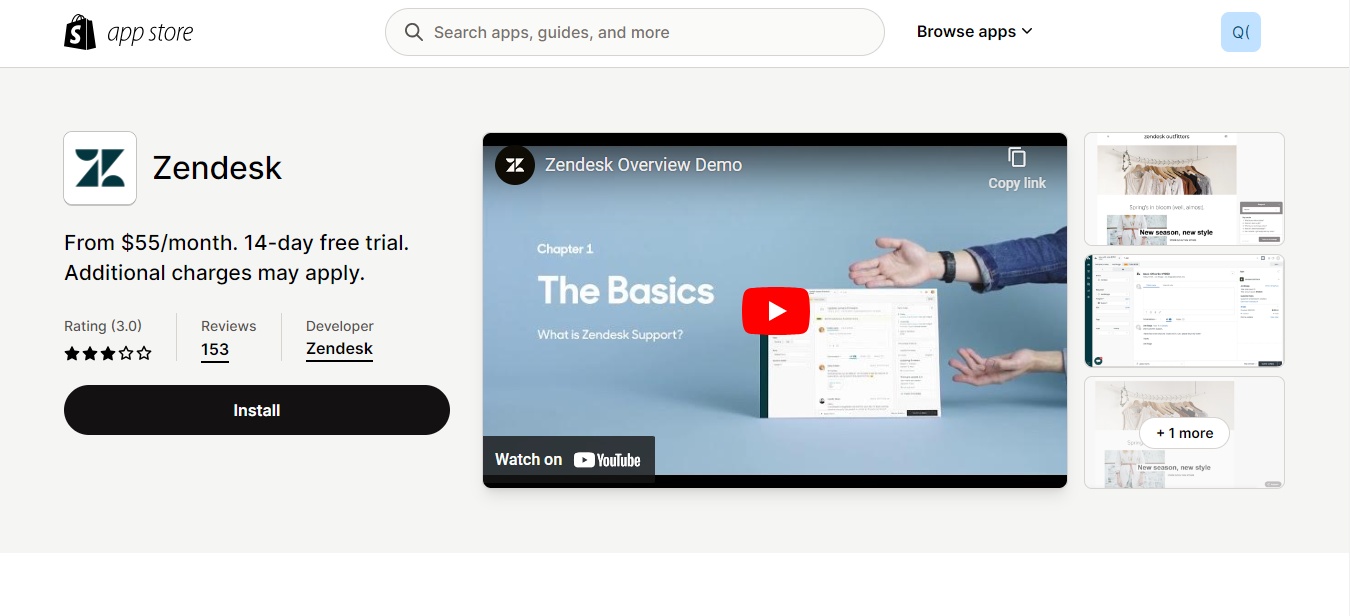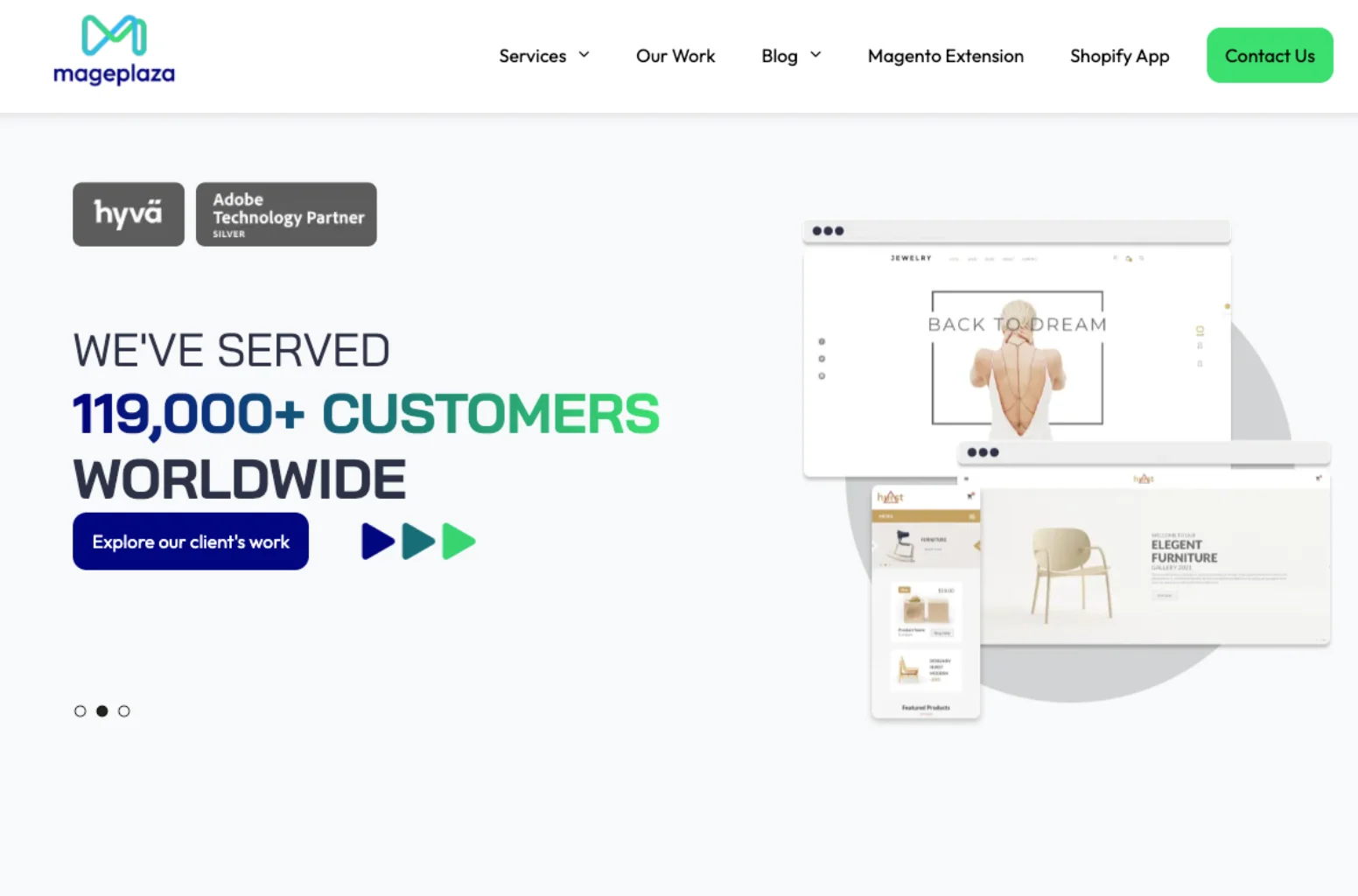Shopify Zendesk Integration: The Comprehensive Guide
Summer Nguyen | 01-28-2024

Zendesk is a customer service and support platform that helps firms manage and streamline customer interactions across various channels. It provides a unified system for handling customer inquiries, support tickets, and communication across email, chat, social media, and more.
Combining Shopify, a leading e-commerce platform, with Zendesk’s customer service software can be a game-changer.
This guide unveils the insights and strategies to master the Shopify Zendesk integration. Let’s explore the possibilities of this powerful fusion together.
Why Should You Integrate Shopify with Zendesk?
Integrating Shopify with Zendesk transforms customer support by streamlining processes, improving efficiency, and enhancing the overall shopping experience. Here are the five biggest benefits:
- Instant access to order details: Support agents can view order history, shipping status, and refund requests directly within Zendesk. Without switching between platforms, they resolve issues faster and with greater accuracy.
- Faster response times: When customers need help, speed matters. By eliminating manual lookups and automating common inquiries, the integration reduces wait times and keeps customers satisfied.
- Seamless order management: Instead of jumping back and forth between Shopify and Zendesk, agents can modify orders, process refunds, and update shipping details—all from a single interface. This convenience saves time and prevents errors.
- Omnichannel support in one place – Whether customers reach out via email, chat, phone, or social media, all interactions are centralized in Zendesk. This ensures a consistent experience across all communication channels.
- Enhanced customer satisfaction and loyalty – When support is quick, efficient, and personalized, customers feel valued. Smoother interactions lead to better reviews, repeat purchases, and long-term brand loyalty.

How to Integrate Zendesk with Shopify
Integrating Shopify with Zendesk can streamline customer support and enhance your e-commerce operations’ overall efficiency. Here is method for easy Shopify Zendesk integration:
Step 1: Set Up Your Zendesk Account
To begin with the Shopify Zendesk Integration, you need to install the Zendesk app in your Shopify store.
Steps to Install the Zendesk App:
- Log into Zendesk: Visit Zendesk and sign in to your account.
- Go to Zendesk Marketplace: Navigate to Admin Center > Apps and Integrations > Zendesk Marketplace.
- Search for Shopify: Find the Shopify app in the marketplace.
- Install the App: Click Install and follow the instructions.
- Authorize Zendesk: Grant necessary permissions for Zendesk to access Shopify data.

Once installed, Zendesk will be ready to pull in relevant Shopify order data.
Step 2: Connect Shopify to Zendesk
To complete the integration, you must connect your Shopify store with Zendesk.
- Log in to Shopify Admin: Visit Shopify Admin and sign in.
- Install the Zendesk App in Shopify: Navigate to Apps > Shopify App Store and search for Zendesk.
- Click Install: Follow the prompts to install the app.
- Enter Zendesk Subdomain: Type your Zendesk subdomain (e.g., yourstore.zendesk.com).
- Authorize Access: Confirm the integration and allow Shopify to share data with Zendesk.
Now, Shopify and Zendesk are connected, allowing real-time access to order details within Zendesk tickets.
Step 3: Configure the Settings
With the connection established, configuring order data display settings ensures that agents can quickly retrieve relevant information when assisting customers. Without this, agents may need to manually search for orders, which can slow down response times.
Let’s explore key settings to enable in Zendesk:
- Display Order Data in Tickets:
- Navigate to Zendesk Admin Center > Shopify App Settings.
- Enable Show Shopify Order Information in Tickets.
- Select which details should appear, such as:
- Order Number
- Order Status (Pending, Fulfilled, Refunded)
- Customer Name and Email
- Total Amount Paid
- Shipping and Tracking Information
- Enable Zendesk Chat on Shopify (Optional):
- If you use Zendesk Chat, enable the chat widget to provide real-time support.
- Copy the Zendesk Chat Script from Zendesk Admin > Chat Widget.
- Paste it into Shopify Admin > Online Store > Themes > Edit Code > theme.liquid, before </body>.
Now, customer service agents will have all necessary order information displayed alongside tickets, leading to more efficient problem resolution.
Step 4: Automating customer support with Shopify Zendesk integration
Automation is key to scaling customer support while maintaining high service quality. By leveraging Zendesk’s automation features, you can streamline order inquiries, refund requests, and shipping updates.
So how to use automation for Shopify Zendesk integration? Here is guide:
-
Create Triggers for Order Events:
-
Automatically generate Zendesk tickets when an order is placed, updated, or refunded.
-
Example: If an order is delayed, a Zendesk ticket can be created to notify the support team.
-
-
Use Macros for Quick Replies:
-
Set up Zendesk Macros for common customer inquiries:
-
“Where is my order?”
-
“Can I modify my order?”
-
“How do I request a refund?”
-
-
Macros allow agents to reply instantly with pre-written, personalized responses.
-
-
Enable AI-Powered Chatbots (Optional):
-
Use Zendesk AI Bots to handle basic Shopify questions before forwarding complex issues to human agents.
-
Step 5: Testing the Shopify Zendesk integration
After setting up the integration, it’s crucial to test everything to ensure that data is syncing correctly and that customer inquiries are being processed efficiently.
Testing checklist include:
| Test Category | Test Steps | Check |
|---|---|---|
| Place a Test Order in Shopify | Create a sample order. | |
| Verify that the order details appear in Zendesk when a ticket is created. | ||
| Submit a Customer Inquiry | Use a test email to submit a Zendesk ticket via live chat, email, or contact form. | |
| Ensure Shopify order data is linked to the ticket. | ||
| Check Automation Triggers | Confirm automatic ticket creation is working as expected. | |
| Verify order notifications are sent properly. | ||
| Check that macros are functioning as expected. |
Challenges in Shopify Zendesk Integration
Integrating Shopify with Zendesk can transform customer support by providing seamless access to order details and improving response efficiency. However, while the integration is designed to streamline support operations, businesses often encounter various technical and operational challenges, such as:
Data sync issues between Shopify and Zendesk
A common challenge businesses face is inconsistent data synchronization between Shopify and Zendesk. If orders fail to appear within Zendesk tickets or display outdated information, agents may struggle to assist customers effectively. This issue is often caused by incorrect integration settings, API rate limits, or Shopify data fetching delays.
To resolve this, businesses should check the Zendesk Admin > Shopify App Settings and confirm that Order Data Sync is enabled. Additionally, manually refreshing data or re-authenticating the connection may help if automatic syncing is delayed.
If the problem persists, businesses should ensure that their API requests are optimized, as excessive manual requests may lead to slower order retrieval times. Running test orders in Shopify and verifying their appearance in Zendesk can help identify sync-related problems early.
Shopify order information not displaying in Zendesk
One of the key benefits of integrating Shopify with Zendesk is the ability to view order details within customer support tickets. However, some businesses experience cases where order information fails to appear, making it difficult for agents to access relevant data quickly.This issue often arises due to misconfigured order display settings, missing customer emails, or permission restrictions.
To fix it, businesses should ensure that the Show Order Information in Tickets option is enabled in Zendesk Admin > Shopify App Settings. Additionally, it is essential to verify that the customer’s email address in Shopify matches the email they used to submit the ticket.
For cases where the order does not link automatically, agents can use the Shopify app sidebar within Zendesk to search for the customer’s email or order number manually.
Slow loading of order data in Zendesk
Even when order data appears within Zendesk, businesses may encounter slow loading times, which can reduce agent efficiency and increase response delays. This issue is particularly noticeable for stores handling a high volume of orders, where Zendesk struggles to retrieve data quickly.
Slow performance is often linked to Shopify API rate limits, large datasets, or excessive manual data requests. To improve loading speeds, businesses should allow automatic syncing rather than manually refreshing order data too frequently. Additionally, reducing the number of past orders displayed can help Zendesk retrieve data faster.
If the issue continues, analyzing Zendesk performance metrics can help determine whether high ticket volumes are affecting system responsiveness.
Limited customization options in Shopify Zendesk Integration
While Shopify Zendesk integration provides essential features, some businesses require custom workflows, advanced ticket routing, or additional data fields that the default integration does not support. The inability to modify how order details are displayed in Zendesk or to customize how support tickets are assigned can limit efficiency.
For businesses that require advanced customization, using Zendesk API and Shopify API can allow for tailored integrations. However, setting up custom workflows often requires technical expertise. For those who need a seamless and hassle-free solution, Mageplaza’s Shopify Integration service offers expert support to customize automation, optimize order data display, and enhance ticket management workflows.

CONSULT WITH SHOPIFY EXPERTS FOR FREE NOW
How Much Does Shopify Zendesk Integration Cost?
Integrating Shopify with Zendesk is an excellent way to improve customer support efficiency, enabling businesses to access real-time order data directly from their helpdesk system. However, the cost of this integration varies depending on the method used, the level of customization required, and the complexity of automation needed. Some businesses may opt for a free basic integration, while others may require third-party apps, middleware automation, or even fully customized API solutions:
Integration Type |
Cost Range |
|---|---|
Zendesk Official App |
Free |
Third-Party App (agnoStack) |
$24/agent/month |
Zapier / SyncSpider |
$20–$299/month |
Custom API Integration |
$5,000–$50,000+ (one-time) |
The Free Option: Zendesk’s Official Shopify App
For businesses looking for a basic integration without additional costs, Zendesk offers an official Shopify app that is completely free. This integration allows customer service agents to view Shopify order details, customer history, and shipping status directly within Zendesk tickets. It provides a simple and effective way to link Shopify and Zendesk, ensuring that agents have access to relevant order data without switching between platforms.
However, while the free integration covers fundamental needs, it lacks advanced automation, deep customization, and workflow enhancements. Businesses that require more sophisticated ticketing, automated actions, and real-time data syncing may find this option limiting.
Third-Party Apps for Premium Features
For businesses that need enhanced order tracking, automation, and workflow optimization, third-party integration apps provide a more powerful solution. One popular option is Shopify Premium for Zendesk by agnoStack, which offers real-time transaction tracking, advanced search capabilities, refund management, and a complete order timeline within Zendesk.
The cost of this premium solution starts at $24 per agent per month, making it an affordable choice for mid-sized businesses that want better automation and deeper Shopify data visibility. Unlike the free Zendesk app, this option allows for more efficient customer interactions, reducing manual work and improving response times.
Middleware Automation Solutions
For businesses that want flexible automation between Shopify and Zendesk without investing in custom development, middleware platforms like Zapier and SyncSpider offer a practical alternative. These tools act as connectors between Shopify and Zendesk, enabling businesses to create automated workflows that update order statuses, generate tickets, and trigger notifications based on specific conditions.
Zapier’s pricing starts at $20 per month for basic automation, while advanced integrations with multiple workflows can cost up to $100 or more per month. Similarly, SyncSpider offers integration plans ranging from $49 to $299 per month, depending on the level of automation required. These solutions are ideal for businesses that need customized workflows but do not want to invest in expensive custom API development.
Custom Shopify Zendesk Integration for Large Businesses
For enterprises and businesses with complex customer service operations, standard integration options may not be sufficient. Custom API integration allows businesses to create a fully tailored Shopify Zendesk integration, enabling complete control over data synchronization, ticketing automation, and multi-store connections.
However, custom integration comes at a significantly higher cost. Depending on the complexity, pricing typically ranges from $5,000 to $50,000 or more for development. The cost is influenced by factors such as multi-store syncing, automation depth, custom ticket routing, and security requirements. While expensive, this approach ensures that businesses get an integration that fully aligns with their unique operational needs.
Read more: 10 Ecommerce Integration Software Boosting Your Online Store
Conclusion
The integration of Shopify and Zendesk is not just a tool; it’s a strategic advantage in the competitive world of e-commerce. It enables you to provide exceptional support that leaves a lasting impression on your customers. And don’t forget to seek feedback from your customers. Their insights are invaluable for refining your support strategies and aligning them with their evolving expectations.







![Top 20+ Must-have Shopify Apps for 2025 [Free & Paid] - Mageplaza](https://cdn2.mageplaza.com/media/blog/must-have-shopify-apps/top-must-have-shopify-apps.png)
![[2025 Updates] Top 10+ Upsell Apps for Shopify - Mageplaza](https://cdn2.mageplaza.com/media/blog/best-upsell-shopify-app/cover.png)